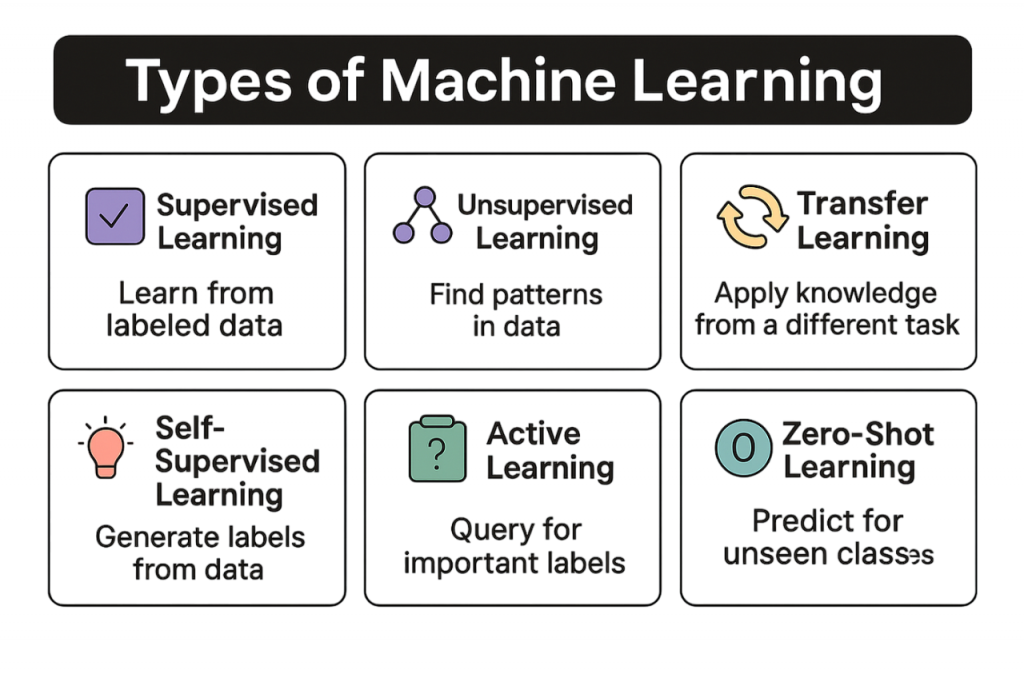
- What is Machine Learning? A Simple Definition
- How Machine Learning Works: Learning from Data
- The Role of Algorithms in Machine Learning
- Machine Learning vs. Traditional Programming
- Common Types of Machine Learning Tasks
- Real-World Applications of Machine Learning
- The Importance of Data Science and AI
- Conclusion
What is Machine Learning? A Simple Definition
Imagine a world where technology learns and improves on its own, like a curious student. This isn’t science fiction; it’s reality powered by Machine Learning. In today’s fast-paced digital age, understanding Machine Learning is no longer just for tech experts. It is the driving force behind many tools and services we use daily, from personalized recommendations on streaming apps to the smart assistants in our homes. This article will provide a clear guide to Machine Learning, breaking down this complex topic into easy-to-understand concepts. To turn that understanding into practical expertise, explore Machine Learning Training a hands-on program designed to help learners build real-world models, master essential algorithms, and apply AI across industries. You’ll learn how this technology works and why it’s important. At its core, Machine Learning is a type of Artificial Intelligence (AI). It allows computer systems to learn from data without being explicitly programmed. Think of it like teaching a child.
How Machine Learning Works: Learning from Data
The “learning” in Machine Learning comes from data. A lot of data! These systems receive huge amounts of information, known as training data. The algorithms, which act like sets of rules or instructions, process this data. To scale these processes efficiently in cloud environments, explore Overview of ML on AWS a practical guide that explains how Amazon Web Services supports data ingestion, model training, and deployment with powerful machine learning infrastructure. They search for relationships, trends, and insights. For instance, if you want a machine learning model to recognize pictures of cats, you would show it thousands of images labeled “cat” and thousands labeled “not cat.” By examining these images, the algorithm learns what features make a cat a cat; its ears, whiskers, tail, and so on.
Ready to Get Certified in Machine Learning? Explore the Program Now Machine Learning Online Training Offered By ACTE Right Now!
The Role of Algorithms in Machine Learning
Algorithms are the brains behind Machine Learning. They are mathematical procedures that analyze data and make decisions. There are many different types of algorithms, each suited for different tasks. Some common ones include: classification, regression, clustering, and optimization. To choose the right framework for implementing these algorithms, explore Keras vs TensorFlow a detailed comparison that highlights the strengths, flexibility, and learning curve of each platform to help you build smarter models faster.
- Supervised Learning: The algorithm is trained on labeled data, which means each data point has a correct answer. This is like learning with a teacher who tells you if you’re right or wrong.
- Unsupervised Learning: The algorithm is given unlabeled data and must find patterns or structures on its own. This is like exploring and discovering without a guide.
- Reinforcement Learning: The algorithm learns by trial and error, receiving rewards for correct actions and penalties for incorrect ones. This is similar to how animals learn tricks.
- Classification: This involves categorizing data into different groups. For example, identifying emails as “spam” or “not spam,” or diagnosing a medical condition based on symptoms.
- Regression: This is about predicting a numerical value. Examples include forecasting stock prices, predicting housing costs, or estimating a car’s fuel efficiency.
- Clustering: This groups similar data points together without knowing the groups in advance. It is useful for market segmentation or identifying customer groups.
- Recommendation Systems: These suggest items to users based on their past behavior or the behavior of similar users. For instance, Netflix recommends movies, and Amazon suggests products.
- E-commerce: Personalized product recommendations, fraud detection, and inventory management.
- Healthcare: Disease diagnosis, drug discovery, and personalized treatment plans.
- Finance: Credit scoring, algorithmic trading, and fraud detection in banking.
- Entertainment: Content recommendations on streaming platforms like Netflix and Spotify.
- Transportation: Self-driving cars, route optimization for delivery services, and traffic prediction.
- Virtual Assistants: Voice recognition and natural language processing that power assistants like Siri, Alexa, and Google Assistant.
To Explore Machine Learning in Depth, Check Out Our Comprehensive Machine Learning Online Training To Gain Insights From Our Experts!
Machine Learning vs. Traditional Programming
Traditional programming requires humans to write specific instructions for every situation. For example, if a program needs to sort numbers, a programmer creates precise code for that task. Machine Learning, on the other hand, trains a model to perform a task by looking at examples. To learn how this process works and apply it to real-world problems, explore Machine Learning Training a hands-on program that guides learners through data preparation, model building, and deployment using industry-standard tools and techniques. Instead of coding the rules for identifying spam emails, you provide thousands of examples of both spam and non-spam emails. The machine learning model learns the traits of spam and can then automatically detect new spam emails. This approach is very effective for tasks that are too complicated or change too often for traditional programming.
Common Types of Machine Learning Tasks
Machine learning is used for many tasks. Here are a few common ones: classification, regression, clustering, and anomaly detection. To explore the platforms that make these tasks easier and more efficient, check out Machine Learning Tools a curated guide that highlights top frameworks like TensorFlow, Scikit-learn, and PyTorch, helping developers streamline workflows and accelerate innovation.

Looking to Master Machine Learning? Discover the Machine Learning Expert Masters Program Training Course Available at ACTE Now!
Real-World Applications of Machine Learning
You interact with machine learning more often than you think. It drives many of the services and devices we use every day. To deepen your understanding of the models behind these technologies, explore Deep Learning Books a curated list of essential reads that cover neural networks, optimization techniques, and real-world applications for aspiring AI professionals.

The Importance of Data Science and AI
Machine Learning is an important part of Data Science and Artificial Intelligence (AI). Data Science focuses on pulling knowledge and insights from data, and machine learning gives us the tools and methods to do this well. AI is the larger idea of making smart machines that can do tasks usually needing human intelligence, and machine learning is one of the main ways we accomplish this. To dive deeper into the core techniques that power these intelligent systems, explore Machine Learning Algorithms a curated guide that explains essential models like decision trees, SVMs, neural networks, and how they’re applied across industries. As the amount of data generated keeps increasing rapidly, machine learning’s role in transforming that data into useful information becomes even more essential.
Preparing for Machine Learning Job Interviews? Have a Look at Our Blog on Machine Learning Interview Questions and Answers To Ace Your Interview!
Conclusion
In summary, Machine Learning is a field that allows computers to learn from data and make smart decisions. It’s not just a complicated idea; it’s a useful technology that is improving our lives in many ways. By understanding what Machine Learning is and its basic principles, we can better appreciate the innovations that are shaping our present and future. To turn that understanding into practical skills, explore Machine Learning Training a hands-on program that helps learners build intelligent models, apply algorithms, and contribute to real-world AI solutions across industries. As this field keeps evolving quickly, its effect on different industries and our daily lives will only increase, making it a key area of knowledge for anyone navigating today’s world.



